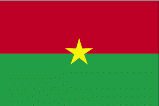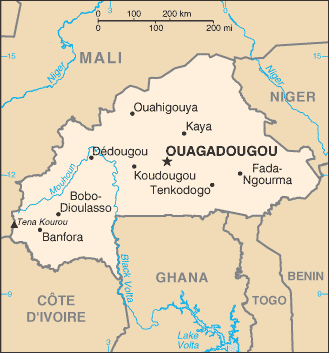|
Burkina Faso
|

|
Capital: Ouagadougou
Population: 20,321,378
Brief History of Burkina Faso:
Prior to the arrival of Europeans, Burkina was ruled by the Mossi. The Mossi were powerful kingdoms of tribes throughout Burkina. The French were the first of the Europeans to arrive and they laid claim to the land in 1896. However, the Mossi fought back. The French took control in 1901, but generally used the Mossi leaders to administer the area.
On August 5, 1960 Burkina Faso became an independent country. Their first president was Maurice Yameogo. The country has since been marred by military coups and power struggles. The country also struggles with high population density and limited natural resources.
The Geography of Burkina Faso
Total Size: 274,200 square km
Size Comparison: slightly larger than Colorado
Geographical Coordinates: 13 00 N, 2 00 W
World Region or Continent: Africa
General Terrain: mostly flat to dissected, undulating plains; hills in west and southeast
Geographical Low Point: Mouhoun (Black Volta) River 200 m
Geographical High Point: Tena Kourou 749 m
Climate: tropical; warm, dry winters; hot, wet summers
Major cities: OUAGADOUGOU (capital) 1.777 million (2009), Bobo Dioulasso
The People of Burkina Faso
Type of Government: parliamentary republic
Languages Spoken: French (official), native African languages belonging to Sudanic family spoken by 90% of the population
Independence: 5 August 1960 (from France)
National Holiday: Republic Day, 11 December (1958)
Nationality: Burkinabe (singular and plural)
Religions: Muslim 50%, indigenous beliefs 40%, Christian (mainly Roman Catholic) 10%
National Symbol: white stallion
National Anthem or Song: Le Ditanye (Anthem of Victory)
Economy of Burkina Faso
Major Industries: cotton lint, beverages, agricultural processing, soap, cigarettes, textiles, gold
Agricultural Products: cotton, peanuts, shea nuts, sesame, sorghum, millet, corn, rice; livestock
Natural Resources: manganese, limestone, marble; small deposits of gold, phosphates, pumice, salt
Major Exports: cotton, livestock, gold
Major Imports: capital goods, foodstuffs, petroleum
Currency: Communaute Financiere Africaine franc (XOF); note - responsible authority is the Central Bank of the
National GDP: $22,100,000,000
** Source for population (2012 est.) and GDP (2011 est.) is CIA World Factbook.
Back to Geography Home Page
